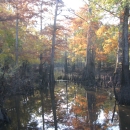About Us
Overflow National Wildlife Refuge (NWR) is a wetland complex within the watershed of Overflow Creek, which flows south along the length of the refuge. On the western boundary, there are approximately 100 acres of upland forests on a narrow strip along the escarpment that separates the Mississippi Alluvial Valley from the Gulf Coastal Plain. The majority of the refuge is bottomland hardwood forests consisting primarily of willow and overcup oaks. Willow oaks produce small acorns that are an excellent food source for the mallards and wood ducks that make their winter home here.
Our Mission
Overflow National Wildlife Refuge (NWR) was established in 1980 to protect the bottomland hardwood forest, a vital habitat for migratory waterfowl populations along the Mississippi Flyway.
Overflow NWR is operated under the following management objectives:
- Provide a diversity of habitat types for migratory waterfowl and other birds;
- Provide habitat and protection for endangered and threatened species;
- Provide opportunities for environmental and ecological research;
- Provide a variety of recreational opportunities consistent with primary wildlife objectives; and
- Expand the public’s understanding of and appreciation for the environment with special emphasis on natural resources.
Other Facilities in this Complex
A National Wildlife Refuge Complex is an administrative grouping of two or more refuges, wildlife management areas, or other refuge conservation areas that are primarily managed from a central office location. Refuges are grouped into a complex structure structure
Something temporarily or permanently constructed, built, or placed; and constructed of natural or manufactured parts including, but not limited to, a building, shed, cabin, porch, bridge, walkway, stair steps, sign, landing, platform, dock, rack, fence, telecommunication device, antennae, fish cleaning table, satellite dish/mount, or well head.
Learn more about structure because they occur in a similar ecological region, such as a watershed or specific habitat type, and have a related purpose and management needs. Typically, a project leader or complex manager oversees the general management of all refuges within the complex and refuge managers are responsible for operations at specific refuges. Supporting staff, composed of administrative, law enforcement, refuge manager, biological, fire, visitor services, and maintenance professionals, are centrally located and support all refuges within the complex.

